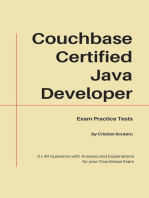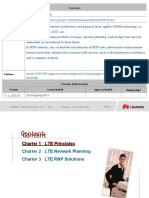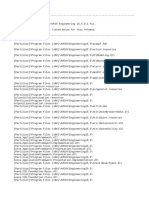0 ratings0% found this document useful (0 votes)
59 viewsCompiler Design
Compiler Design
Uploaded by
Shubham KumarThe document discusses key concepts in compiler design including:
1) Peephole optimization involves optimizing small sequences of instructions. A code generator should be machine independent, handle complex addressing modes, and optimize for speed and size.
2) A DAG (directed acyclic graph) is a graph with nodes and edges with a direction that does not form cycles. DAGs are used in code optimization to represent the data and control dependencies between instructions.
3) Basic blocks are sequences of instructions with one entry and exit point. Control flow graphs represent the flow of a program using basic blocks and edges.
4) Activation records store local variables, parameters, return addresses, and more during procedure calls.
Copyright:
© All Rights Reserved
Available Formats
Download as PDF, TXT or read online from Scribd
Compiler Design
Compiler Design
Uploaded by
Shubham Kumar0 ratings0% found this document useful (0 votes)
59 views2 pagesThe document discusses key concepts in compiler design including:
1) Peephole optimization involves optimizing small sequences of instructions. A code generator should be machine independent, handle complex addressing modes, and optimize for speed and size.
2) A DAG (directed acyclic graph) is a graph with nodes and edges with a direction that does not form cycles. DAGs are used in code optimization to represent the data and control dependencies between instructions.
3) Basic blocks are sequences of instructions with one entry and exit point. Control flow graphs represent the flow of a program using basic blocks and edges.
4) Activation records store local variables, parameters, return addresses, and more during procedure calls.
Original Description:
Complier design imp ques
Original Title
Compiler design
Copyright
© © All Rights Reserved
Available Formats
PDF, TXT or read online from Scribd
Share this document
Did you find this document useful?
Is this content inappropriate?
The document discusses key concepts in compiler design including:
1) Peephole optimization involves optimizing small sequences of instructions. A code generator should be machine independent, handle complex addressing modes, and optimize for speed and size.
2) A DAG (directed acyclic graph) is a graph with nodes and edges with a direction that does not form cycles. DAGs are used in code optimization to represent the data and control dependencies between instructions.
3) Basic blocks are sequences of instructions with one entry and exit point. Control flow graphs represent the flow of a program using basic blocks and edges.
4) Activation records store local variables, parameters, return addresses, and more during procedure calls.
Copyright:
© All Rights Reserved
Available Formats
Download as PDF, TXT or read online from Scribd
Download as pdf or txt
0 ratings0% found this document useful (0 votes)
59 views2 pagesCompiler Design
Compiler Design
Uploaded by
Shubham KumarThe document discusses key concepts in compiler design including:
1) Peephole optimization involves optimizing small sequences of instructions. A code generator should be machine independent, handle complex addressing modes, and optimize for speed and size.
2) A DAG (directed acyclic graph) is a graph with nodes and edges with a direction that does not form cycles. DAGs are used in code optimization to represent the data and control dependencies between instructions.
3) Basic blocks are sequences of instructions with one entry and exit point. Control flow graphs represent the flow of a program using basic blocks and edges.
4) Activation records store local variables, parameters, return addresses, and more during procedure calls.
Copyright:
© All Rights Reserved
Available Formats
Download as PDF, TXT or read online from Scribd
Download as pdf or txt
You are on page 1of 2
5CS4-02: Compiler Design
Q.1 Write short Answers
(i) Define peephole optimization
(ii) Mention the properties that a code generator should possess
(iii) What is a DAG? Mention its applications
(iv) What are the basic goals of code movement?.
(v) What are the different data flow properties?
(vi) Write difference between ‘Call by Value’ and ‘Call by Reference’
(vii) What is Basic block?
(viii) What is Control flow graph?
(ix) What is Activation Record? Explain its format.
(x) What is Symbol table?
(xi) Explain the storage allocation strategies.
(xii) Explain the flow graph with example.
(xiii) Explain the basic block with example.
(xiv) Explain the difference between stack allocation and heap allocation.
(xv) Explain the code motion with example.
Q.2 (i) What are the contents of activation record?
(ii) What are the different data flow properties?
(iii) What do you mean by machine dependent and machine independent
optimization.
(iv) (a)Differentiate between stack allocation and heap allocation (b) machine
idioms
(v) What are the basic goals of code movement
(vi) Explain the symbol table management system.
(vii) Explain all the issues of Source Language.
(viii) What is the difference between local and non local data? Explain with
example.
(ix) Construct the DAG and generate the code for given block
d: = b+c
e: = a*b
b: = b-c
a: = e*d
(x) Explain loop invariant computation by using LICM algorithm
(xi) Explain Peephole optimization with example
(xii) Write appropriate method for constructing a DAG for a basic block.
(xiii) Explain optimization of basic blocks.
(xiv) Explain general structure of an activation record.
(xv) Construct the DAG for the following block of statements:
a=b*c
d=b
e=d*c
b=e
f=b+c
g=f+d
(xvi) Explain principal source of code optimization.
(xvii) Explain loop invariant computation.
Q.3 (i)
Mention the issues to be considered while applying the techniques for code
optimization
(ii) Explain the various runtime storage management technique, with suitable
programming example
(iii) What do you understand by DAG? Write an algorithm for constructing a DAG
(iv) What is Calling sequence? Explain the process of calling sequence for a
procedure.
(v) Write an algorithm to divide a program into basic blocks with the help of
program code with example.
(vi) Explain the issues in Code generation technique?
(vii) Explain peephole optimization.
(viii) Explain the list data structure foe symbol tables.
(ix) Explain the symbol table management system.
You might also like
- Ovation Data Acquisition - OV100Document4 pagesOvation Data Acquisition - OV100Usman Younis0% (1)
- Data Structures and Algorithm Review QuestionsDocument2 pagesData Structures and Algorithm Review QuestionsHenry Kaweesa100% (3)
- Java Mock PRA 12 3 SolutionsDocument8 pagesJava Mock PRA 12 3 SolutionsRahul NaikNo ratings yet
- Group A: SUMMER 2005 Computing and InformaticsDocument37 pagesGroup A: SUMMER 2005 Computing and InformaticsAjay KumarNo ratings yet
- BCS 11Document5 pagesBCS 11allenantony200325No ratings yet
- JK Bose Class 12 Computer Science 6031 C 2022Document4 pagesJK Bose Class 12 Computer Science 6031 C 2022hatimfrqNo ratings yet
- Full Marks: 100 Time: 3 Hours The Question Are of Equal Value Answer Five Questions Including Question 1 Which Is CompulsoryDocument4 pagesFull Marks: 100 Time: 3 Hours The Question Are of Equal Value Answer Five Questions Including Question 1 Which Is CompulsorySONI KUMARINo ratings yet
- Hpu Bca 4th Sem Paper of Internet Technology&webpagedesignDocument4 pagesHpu Bca 4th Sem Paper of Internet Technology&webpagedesignchauhangoli2425No ratings yet
- 12IT225 Essentials of Information Technology Model QuestionDocument1 page12IT225 Essentials of Information Technology Model QuestionmathuNo ratings yet
- Sample Paper of Class XiDocument2 pagesSample Paper of Class XiVinay BalaniNo ratings yet
- Choose The Correct Answer of The Following: (A)Document4 pagesChoose The Correct Answer of The Following: (A)lefela6421No ratings yet
- SKR Engineering College: Department of Computer Science & Engineering Model Question Paper CS 1151 - Data StructuresDocument4 pagesSKR Engineering College: Department of Computer Science & Engineering Model Question Paper CS 1151 - Data StructuresctvenkatNo ratings yet
- Question Paper - OopDocument13 pagesQuestion Paper - OopRajesh KumarNo ratings yet
- Css Computer Science 2021Document2 pagesCss Computer Science 2021Hamza KhanNo ratings yet
- EC2202 DSOOP Anna Question PapersDocument11 pagesEC2202 DSOOP Anna Question PapersabinayamalathyNo ratings yet
- ComputerDocument50 pagesComputerx yNo ratings yet
- It Nov06Document21 pagesIt Nov06api-3825774No ratings yet
- Computer Science 2021Document5 pagesComputer Science 2021Ifthikhar AhmadNo ratings yet
- CSE MARCH 2023 Advanced Database SystemsDocument4 pagesCSE MARCH 2023 Advanced Database Systemskalyaniprabhudesai2211No ratings yet
- SRM University, Katankulathur - 603203 Software EnginringDocument2 pagesSRM University, Katankulathur - 603203 Software EnginringVivekanandhan VijayanNo ratings yet
- 12th CS 1 Prelims Exam 26 - 03 - 2021Document4 pages12th CS 1 Prelims Exam 26 - 03 - 2021naveenkenchgunde10No ratings yet
- Gate CS - 1992Document9 pagesGate CS - 1992VarshaNo ratings yet
- C Imp 1Document2 pagesC Imp 1sepoged319No ratings yet
- UntitledDocument3 pagesUntitledAnupam GyawaliNo ratings yet
- Fill in The Blanks: C++ Important QuestionDocument3 pagesFill in The Blanks: C++ Important QuestionFatemaNo ratings yet
- HDL 2017 PDFDocument3 pagesHDL 2017 PDFUtkarsh UgvekarNo ratings yet
- C0-R4.B4 Page 1 of 2 January, 2019 (6+6+6)Document2 pagesC0-R4.B4 Page 1 of 2 January, 2019 (6+6+6)sanjay sheeNo ratings yet
- SPCC May17Document2 pagesSPCC May17Tanisha PoojariNo ratings yet
- MCS 207Document7 pagesMCS 207pramod kumar yadavNo ratings yet
- 320 Web ApplicationDocument5 pages320 Web ApplicationjacobNo ratings yet
- 3 Hours / 70 Marks: Seat NoDocument2 pages3 Hours / 70 Marks: Seat NoTanishka PatilNo ratings yet
- North West Mock 2017 Paper 2Document4 pagesNorth West Mock 2017 Paper 2Evody tembiNo ratings yet
- C S Class 12 Model Test Papers 3Document4 pagesC S Class 12 Model Test Papers 3Gamer GuyNo ratings yet
- Unix and Shell ProgrammingDocument4 pagesUnix and Shell ProgrammingWael AbdulalNo ratings yet
- BCS 011Document4 pagesBCS 011saifiumer28No ratings yet
- Class Xii Sample Paper Computer Science Set-Iii PDFDocument3 pagesClass Xii Sample Paper Computer Science Set-Iii PDFSaurabh jaiswalNo ratings yet
- IpQuestion Paper Along With Answer KeyDocument6 pagesIpQuestion Paper Along With Answer KeyRonit Deb50% (2)
- CS 2015Document2 pagesCS 2015Sandeep SanodiyaNo ratings yet
- Question Paper Code:: Reg. No.Document4 pagesQuestion Paper Code:: Reg. No.krithikgokul selvamNo ratings yet
- BCS 011Document4 pagesBCS 011chaitanya lakkakulaNo ratings yet
- Computer Basic and PC Software AssignmentDocument28 pagesComputer Basic and PC Software AssignmentBishaz ShiwakotiNo ratings yet
- CS, Core - 11, 5th SemDocument3 pagesCS, Core - 11, 5th SemManas PanigrahiNo ratings yet
- Sem 4 RecentquepaperDocument9 pagesSem 4 Recentquepapersankettech974No ratings yet
- Question BCS011Document88 pagesQuestion BCS011sdfbfbbgvNo ratings yet
- Marks 0 7 Hours / 3: Seat NoDocument3 pagesMarks 0 7 Hours / 3: Seat NoManasvi DevlekarNo ratings yet
- (CBCS) : B.C.A. (2016-17 Onwards) Computer Science 604 ProgrammingDocument2 pages(CBCS) : B.C.A. (2016-17 Onwards) Computer Science 604 ProgrammingVIP StudiosNo ratings yet
- 2009 Web Technology: CS/B.Tech (IT) /SEM-7/IT-702/2009-10Document4 pages2009 Web Technology: CS/B.Tech (IT) /SEM-7/IT-702/2009-10Krishanu MondalNo ratings yet
- 2021 Mca 20 21Document2 pages2021 Mca 20 21sohilnikhilNo ratings yet
- 3rd - semesters-Pyqp'S - March-April-2021 - Mca (Management) 2020 PatternDocument15 pages3rd - semesters-Pyqp'S - March-April-2021 - Mca (Management) 2020 Patternshubhamsonavane6989No ratings yet
- 159.102 Computer Science Fundamentals - Massey - Exam - S2 2019Document5 pages159.102 Computer Science Fundamentals - Massey - Exam - S2 2019DonNo ratings yet
- BCS 011Document3 pagesBCS 011pelav27511No ratings yet
- ,,,,Document44 pages,,,,nikkix2412No ratings yet
- BCS-011 D17 - CompressedDocument4 pagesBCS-011 D17 - CompressedotuneschannelNo ratings yet
- Python 1Document6 pagesPython 1shrigopikasnacksNo ratings yet
- Compiler-All-Anna-Question Till Nov-2016 PDFDocument39 pagesCompiler-All-Anna-Question Till Nov-2016 PDFBuvana MurugaNo ratings yet
- MCS-012-D14 - CompressedDocument3 pagesMCS-012-D14 - CompressedSongYak YamNo ratings yet
- Webtech Que PaperDocument4 pagesWebtech Que Papershivrajchavan3000No ratings yet
- 6577 AllDocument3 pages6577 AllProsenjit MukherjeeNo ratings yet
- ND-2020-CS 2352-Principles of Compiler DesignDocument2 pagesND-2020-CS 2352-Principles of Compiler DesignvijayalakshmisNo ratings yet
- Embedded Software Design and Programming of Multiprocessor System-on-Chip: Simulink and System C Case StudiesFrom EverandEmbedded Software Design and Programming of Multiprocessor System-on-Chip: Simulink and System C Case StudiesNo ratings yet
- Java / J2EE Interview Questions You'll Most Likely Be AskedFrom EverandJava / J2EE Interview Questions You'll Most Likely Be AskedNo ratings yet
- VennDocument20 pagesVennShubham Kumar100% (1)
- Merge SortDocument13 pagesMerge SortShubham KumarNo ratings yet
- Scanned by CamscannerDocument23 pagesScanned by CamscannerShubham KumarNo ratings yet
- AoA Important QuestionDocument3 pagesAoA Important QuestionShubham KumarNo ratings yet
- C++ Project On Police Stations Oftware-131216072242-Phpapp02Document32 pagesC++ Project On Police Stations Oftware-131216072242-Phpapp02Shubham KumarNo ratings yet
- User GuideDocument440 pagesUser GuideraNo ratings yet
- Bluetooth Positioning Using RSSI and Triangulation Methods: January 2013Document7 pagesBluetooth Positioning Using RSSI and Triangulation Methods: January 2013Aldo AriakusumahNo ratings yet
- Dell Latitude E6420 Beep Codes Diagnostic IndicatorsDocument3 pagesDell Latitude E6420 Beep Codes Diagnostic IndicatorsrayNo ratings yet
- LTE Network Planning - Huawei TechnologiesDocument54 pagesLTE Network Planning - Huawei TechnologiesayodNo ratings yet
- 08 Lecture2Document23 pages08 Lecture2Abhishek yadavNo ratings yet
- Chapter 1 UETDocument70 pagesChapter 1 UETAnh HoangNo ratings yet
- 1 - Tencent VooV Meeting - User ManualDocument11 pages1 - Tencent VooV Meeting - User ManualAptu Andy KurniawanNo ratings yet
- Roche CEDEX HiRes ManualDocument287 pagesRoche CEDEX HiRes ManualJin Woo LeeNo ratings yet
- CCN OelDocument7 pagesCCN OelAbdul ShakoorNo ratings yet
- Mohammed Shafi: Work ExperienceDocument3 pagesMohammed Shafi: Work ExperienceDhanashree HiwaseNo ratings yet
- Grade7 Q0 W4 PerformMensuration for-STUDENTDocument32 pagesGrade7 Q0 W4 PerformMensuration for-STUDENTMICHAEL USTARENo ratings yet
- Fs QB: Question Bank and AnswersDocument91 pagesFs QB: Question Bank and AnswersArun Kumaar SrinivasanNo ratings yet
- Manual For VK162-12 PCB Rev3.0Document37 pagesManual For VK162-12 PCB Rev3.0FrogfootNo ratings yet
- Tia 14 SP1Document8 pagesTia 14 SP1dgfjkhNo ratings yet
- Academic Audit Report: PG and Research Department of Computer ApplicationsDocument14 pagesAcademic Audit Report: PG and Research Department of Computer ApplicationsBasil AhamedNo ratings yet
- Ip Addressing Sample Questions and How To AnswerDocument1 pageIp Addressing Sample Questions and How To AnswerAZILATULHANA MAT DAUDNo ratings yet
- Be Summer 2022Document1 pageBe Summer 2022Drashti BabariyaNo ratings yet
- Adbms Mini Sem 5-1Document10 pagesAdbms Mini Sem 5-1Harshad BhavarNo ratings yet
- Excel Practical# 09 Calculate Average, Minimum & MaximumDocument2 pagesExcel Practical# 09 Calculate Average, Minimum & MaximumSarim KayaniNo ratings yet
- Python For Beginners - The Crash - Aaron KhanDocument83 pagesPython For Beginners - The Crash - Aaron KhanMarcos Antônio Rocha TenórioNo ratings yet
- Defense in Depth Network Perimeter SecurityDocument113 pagesDefense in Depth Network Perimeter SecurityFasiledes TarekegnNo ratings yet
- User Manual For Bluetooth Pro Controller For Nintendo SwitchDocument6 pagesUser Manual For Bluetooth Pro Controller For Nintendo SwitchDiego Jose Del Angel HerreraNo ratings yet
- Faraz SourceDocument13 pagesFaraz SourceHarshit AroraNo ratings yet
- Fairchild Display Power SolutionDocument58 pagesFairchild Display Power SolutionFrancisco Antonio100% (1)
- T 53201Document217 pagesT 53201Abhijeet WayaseNo ratings yet
- Intel Microprocessor I3, I5, I7Document22 pagesIntel Microprocessor I3, I5, I7Himanshu Nath100% (2)
- Topic - Protocol Stacks of Internet: Assignment - 1Document14 pagesTopic - Protocol Stacks of Internet: Assignment - 1PREETI -No ratings yet
- Gridadvisor Series II Smart Sensor Catalog Ca915001enDocument4 pagesGridadvisor Series II Smart Sensor Catalog Ca915001endanilogomezNo ratings yet






























































































